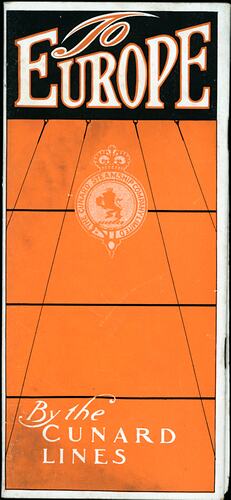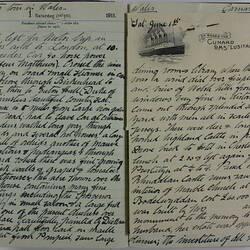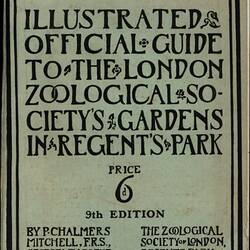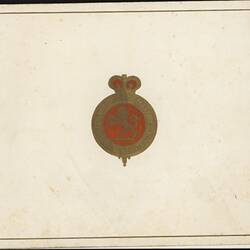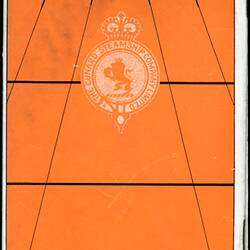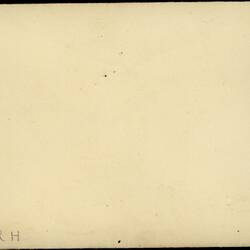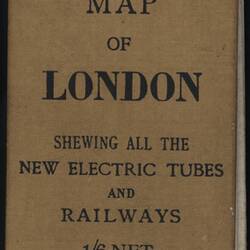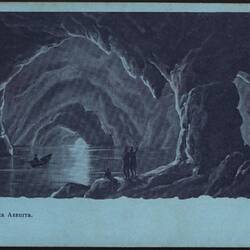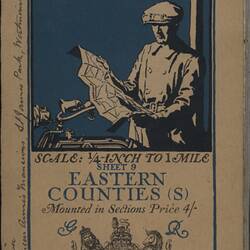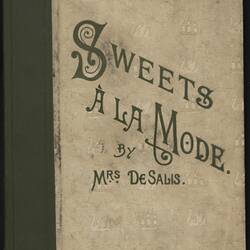In 1911 Miss Olive Oliver, a wealthy 32 year old woman from Melbourne, embarked on a round-the-world tour of the United States of America, Britain and Europe. Olive travelled with her father, William Oliver, her brother, William Donald ('Don'), and her cousin, Gretta Affleck. Throughout the trip, Olive kept a travel diary and collected brochures, postcards, menus, concert programs and maps from the places she visited. Museum Victoria has acquired these items as well as Olive's large wooden sea chest, and together these make up the Olive Oliver collection.
After touring through the United States of America, Olive set sail from New York on 21 June 1911, travelling on the luxury ocean liner, the RMS Lusitania, to Liverpool, England (the RMS Lusitania was later famously torpedoed without warning by a German U-boat on 7 May 1915 during World War One, an attack that killed over 1,000 passengers and was influential in drawing the USA into the war). From Liverpool Olive began a short motor tour through Wales to London. With Chauffeur Matthew at the helm of the 40 horse power Mercedes car, Olive sped 'through splendid scenery & lovely roads with hedges of Hawthorn, briar roses & honey suckle wild every here & there', visited old castles, walked through the gardens of majestic estates and admired the mountains, lakes and falls near Bala. In Stratford-on-Avon Olive saw the sites of Shakespeare's home town and in Oxford visited the University Colleges before arriving in London on 7 July 1911.
Olive soon rented a flat at the Queen Anne's Mansions in Westminster where she and Gretta stayed for the next two months. Olive's days in London were filled with matinees at the theatre, walks in Hyde Park, visits to the National Gallery, lunches, afternoon teas and shopping. Liberty and Harrods were the stores Olive most frequented as she built up her wardrobe with a muslin dress, a crepe blouse, hats, skirts, coats, and readymade frocks.
On 19 August 1911, Olive again began travelling with her father, brother and Gretta, this time on a five week motor tour of Scotland. The tour began by winding through the fishing towns of Lowestoft and Yarmouth, the cathedrals at Norwich and Lincoln, and the old churches and abbeys near Jedburgh and Kelso. The travellers stayed in Edinburgh for four nights where, between sipping tea in tea rooms along Princes Street and buying a souvenir tartan rug, they visited the city's sites by carriage, including Edinburgh Castle. In the following days as they travelled further north, they also visited Rosslyn, Stirling and Balmoral Castles, but it was the 'grand' scenery of Scotland's hills, lochs and 'rugged' moors that seemed to impress Olive most.
When motoring south, the party stopped in Oban which was hosting 'the Games' so allowed Olive to be spectator to 'Highlanders' throwing weights and hammers, tossing the Caber and vying for the title of the bagpipe competition. The travellers also spent three nights in Glasgow before crossing back into England where, on the final day before returning to London, they motored through 'the Dukeries', a recognised tourist trail through the county seats of several dukes. Olive visited the impressive estates of the Duke of Devonshire and the Duke of Portland as well as the two largest oak trees 'in the Kingdom' at Sherwood Forest. Olive seemed most excited, however, by viewing the 'top of wide wall' of the Duke of Portland's uninhabited castle where Mary Queen of Scots once 'drove a carriage & pair for a wager'.
On 22 September 1911, Olive returned to London and to the Queen Anne's Mansions where she and Gretta stayed for another two months. Olive's time here followed a similar pattern to her earlier stay in London. During the day she saw a matinee at one of the many London theatres, wandered through the Tate or Portrait Galleries, or took a taxi to the Zoo. During the evenings it was plays and concerts that kept Olive busy, including the Russian Ballet at Covent Garden Theatre, Mousmé at Shaftesbury Theatre or The Follies at the Apollo Theatre.
Olive also recorded in her diary a visit to Buckingham Palace to see the King and Queen leave for the Indian Durbar (a coronation ceremony in India) on 11 November 1911; a meeting of the women's suffrage organisation, Actresses Franchise, at the Criterion Restaurant; and going for the very first time on 'the new sliding stairway at Earls Court station' (an escalator). As the result of many shopping visits Olive added evening dresses, evening shoes, coats, skirts, hats and a mauve petticoat to her wardrobe. Many of these would have been packed into the large wooden and cane trunks, hat boxes and hampers that Olive shipped to Australia from the Orient Line office in London, lightening her load in preparation for the next stage of her trip.
Olive farewelled London on 23 November 1911 and, together with her father, brother and Gretta, sailed to France to begin a tour of Europe's major cities. In Paris, Olive travelled by carriage from the Eiffel Tower, to Les Invalides, to Place de la Concorde, Notre Dame and the Louvre. One day was spent looking over the palace and grounds of Versailles while on another day, as snow fell on the ground, the party motored through the forests and to the castle of Fontainebleau. After a little more site-seeing, a touch of shopping, and a night at the Olympia Music Hall, Olive caught the train to Brussels.
Her time in Brussels was focused on exploring the history of the battle of Waterloo - Olive visited the sites of different armies, climbed a mound built by the Prussians, and perused collections of souvenirs from the battle that included swords, cannon balls and even Napoleon's cup and saucer. From Brussels, Olive caught the train to Holland to first visit Antwerp and then Amsterdam where she visited galleries filled with the works of artists such as Rembrandt, Rubens and de Vinci. Olive also got a feel for the county side during a windmill and canal dotted journey to the 'sweetly, pretty and quaint fishing town' of Volendam where the people were dressed in national costume and the sea shore was lined with 'picturesque old fishing boats'.
Next it was the palaces and cathedrals of Germany that Olive visited, including the Kaiser's Palace in Berlin, Sanssouci; the former castle of Frederick the Great in Potsdam; and the King's palaces in Dresden. Of particular note was the surprise of having the Kaiser's third son, wife and three bull dogs pass through Sanssouci's rooms while Olive was admiring them. From Dresden, the train took Olive through Bohemia and Hungary to Vienna where the Oliver family had a friend, Stewart, with whom they had afternoon tea, went to the Opera, and exchanged gifts as Christmas drew near.
On the 23 December 1911, the party travelled to Munich and, while Christmas day was spent very quietly, Christmas Eve saw everyone at the Hofbrauhaus, a beer salon and restaurant, where 'all tasted beer & had long sticks of bread (quaint old blue mugs with pewter lids & large handles)'. The last days of the year were spent enjoying the 'glorious scenery' at Lake Lucerne and tobogganing in Engelberg high up in the mountains of Switzerland.
While the diary closes on 31 December 1911 with Olive taking a long afternoon walk in Engelberg, Olive's journey did not end there. She continued to travel through Europe with her father, brother and Gretta for several more months, but the diary in which this was recorded has been lost.
If anyone has any further information about Olive Oliver, please contact Museums Victoria.
More Information
-
Keywords
-
Authors
-
Article types
